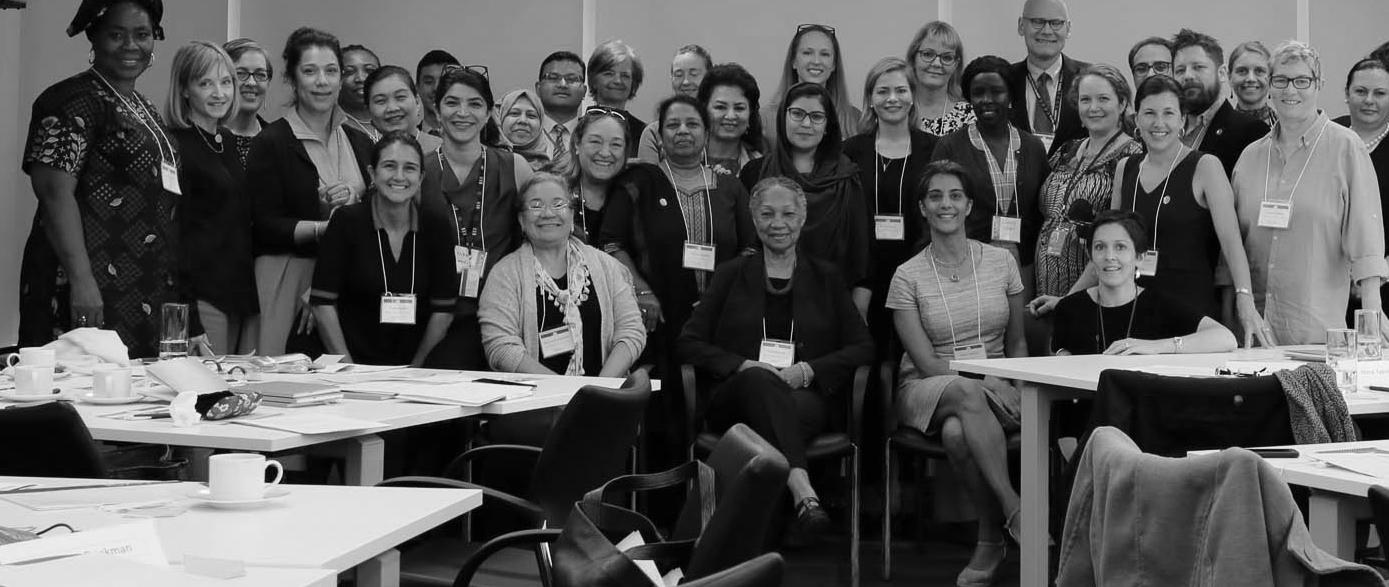
16 minute read
Conclusions and Recommendations
Women peacebuilders work to build peace, justice, and security in their communities in the most difficult, conflict-affected environments and at enormous personal and professional risk. Their work is dangerous by nature because they challenge established power dynamics and engage across differences. They build bridges between conflicting groups and develop trust and credibility with all stakeholders, including violent actors on multiple sides; relationships can help protect women peacebuilders, but can also directly or indirectly endanger them and their work. As a result of their critical role, like bridges, women peacebuilders are often the first to be targeted by parties seeking to perpetuate conflict. Rosa Emilia Salamanca has first-hand experience of these dynamics in Colombia:
We have to learn how to live together, and in such a polarized society the main issue is to make people realize that. The context is complex; we know we have a peace agreement, but some would say that peace has divided us, some are closing ranks so that nothing will change. In other words, those involved in conflict are coming together to undo what women peacebuilders are doing to gain peace.53
The following recommendations provide practical guidance for states and multilateral organizations to contribute to the safety of women peacebuilders by reducing risk, preventing threats to them and their work, and responding effectively to provide protection.
To facilitate understanding and implementation, the guidance is organized in four sections outlining what to do and making specific suggestions as to how to do it. Each set of guidance varies in relevance to different branches, departments, agencies, and units of states and multilateral organizations. The recommendations are designed to be specific enough to operationalize while broad enough to be applied by different entities.
international, national and institutional policy and culture that make women peacebuilders vulnerable.
Prevention, Mitigation and Response to Threats to Women Peacebuilders on the
Ground outlines steps that can be taken to reduce risk of, prepare for and respond to threats, harassment and attacks they face in the course of their lives and work within their communities and society.
Security for Women Peacebuilders at the Peace Table and in International Spaces
addresses the particular issues around and needs of women peacebuilders to ensure their safe participation in international events such as peace negotiations and briefings.
Necessary outlines actions to facilitate emergency relocation and assistance for women peacebuilders, as needed, in the case of acute threats.
Operational Guidance to Establish and Enhance the Protection of Women Peacebuilders

Build mutually beneficial relationships with women peacebuilders; networks can serve as a form of protection. HOW TO DO IT
Include the recognition and safety of women peacebuilders explicitly in the mandate of gender and WPS focal points, where they exist, including those in government ministries and foreign and multilateral missions:
Conduct regular bilateral consultations with women peacebuilders, their organizations, and their networks to understand their work and the risks and threats they face:
Where missing, establish WPS focal points within all state and multilateral entities to carry out this mandate.
Strengthen the role of and resource WPS and gender focal points.
Following best practices,54 ensure the inclusion of women peacebuilders from different geographic areas and diverse identities including race, ethnicity, religion, age, gender, sexual orientation, disability, and socio-economic backgrounds.
Support the development of security sector policies and procedures to clarify roles and responsibilities and strengthen coordination mechanisms to respond to threats against women peacebuilders.
With their consent, attend women peacebuilders’ events and observe their activities to become familiar with their work and to fulfill vetting requirements.
Facilitate collaboration between WHRDs and women peacebuilders by ensuring inclusive criteria for participation where possible and mutual reinforcement of their work.
Establish and facilitate open channels of communication with the security sector, including local liaison officers and protection specialists, and referral mechanisms that are accessible to women peacebuilders.
Develop Minimum Security Operating Standards (MSOS), designed to establish standard criteria for security arrangements to ensure the safety of women peacebuilders.
Highlight the risks and threats women peacebuilders face, giving priority to their analysis as they are experts on their own situation. Incorporate the expertise of women peacebuilders in context analyses, particularly those focused on conflict, stabilization, humanitarian response, development, and violence prevention.
Conduct joint risk assessments with women peacebuilders and co-design and implement mitigation strategies:
Leverage convening power to foster alliances between women peacebuilders and other stakeholders (including state entities, multilateral organizations, and civil society) to raise awareness of and enable robust responses to threats.
Engage technology companies to educate them about the online threats and attacks faced by women peacebuilders and to enhance protocols for limiting, reporting, and when appropriate, removing harmful online content.
Revise existing international and national laws, policies and guidelines for the protection of human rights and women human rights defenders to:
Explicitly include women peacebuilders;
Ensure provisions are gender-responsive; and
Address the specific risks associated with the nature of women’s peacebuilding work. Apply a gender responsive, intersectional approach to identify risks, vulnerabilities, and threats.
Develop targeted strategies to promote acceptance of women peacebuilders’ work and reduce threats.
Include the rights and security of women peacebuilders explicitly in the mandate of national human rights institutions (NHRIs) and ensure that they are empowered to:
Monitor and report on the situation of women peacebuilders, specifically;
Coordinate the state’s response to threats against them; and
Periodically evaluate the efficacy of the state’s response.
Regularly engage international human rights treaty bodies to raise concerns about the safety of women peacebuilders and report on threats and violence against them:
Encourage the UN Special Rapporteurs on the Situation of Human Rights Defenders, Violence Against Women, Extra-judicial Summary or Arbitrary Executions, Torture, and the Promotion and Protection of Human Rights and Fundamental Freedoms while Countering Terrorism to report on the insecurity of women peacebuilders off and online. Develop implementation plans for policies and guidelines, where needed, to inform national legislation and enable change in practices.
Enact legislation55 institutionalizing WPS policies and practices, including provisions for the protection of women peacebuilders that include allocation of resources, monitoring, and accountability mechanisms.
Revise existing laws that aid in the criminalization, prohibition, or stifling of women peacebuilders and their work, particularly counterterrorism laws. Develop an inclusive consultative process to draft WPS legislation in close collaboration with women peacebuilders, policymakers and parliamentarians.
Map the relevant laws, policies and practices to identify key entry points, source material and key stakeholders.
Identify or develop example language for use in legislation and share best practices for gender responsive policymaking and budgeting.
Write inclusive, consultative processes into legislation, such as regular staff briefings by women peacebuilders, as well as implementation plans, monitoring mechanisms and reporting requirements.
Advocate bilaterally and within global and regional coordination bodies to ensure that international and national counterterrorism laws and policies enable peacebuilding and protect women peacebuilders.
Engage authorities responsible for implementing Anti-Money Laundering and Counter-Terrorism Financing (AML/CTF) rules to familiarize them with women peacebuilders, their organizations and activities in order to prevent and redress limitations on their work.
WHAT NOT TO DO
Do not threaten women peacebuilders, their families, their colleagues, or their work.
Do not isolate women peacebuilders by excluding them from key political and policy arenas.
Do not ignore women peacebuilders’ perspectives in conflict analysis and security assessments.
Do not assume that existing protection mechanisms are sufficient to meet women peacebuilders’ needs or that women peacebuilders identify as WHRDs.
Do not adopt WPS policies and plans without having made a gender and risk analysis aiming to enhance the safety and security of women peacebuilders.
Do not adopt WPS policies and plans without accompanying and enforceable legislation, monitoring and accountability mechanisms and dedicated resources.
Do not criminalize women peacebuilders or constrain their work through unwarranted legal and administrative proceedings.
Do not instrumentalize women peacebuilders and securitize their work by using them as an intelligence source in support of interventions unaligned with a human security approach.
Prevention, Mitigation and Response to Threats to Women Peacebuilders on the Ground

WHAT TO DO
Establish protection guidelines and protocols for engagement with women peacebuilders to reduce risk and enable response to threats as they arise. HOW TO DO IT
Designate a protection focal point within each organization or entity (e.g., embassy, mission, ministry) to coordinate responses in the event of an acute threat. This could be the WPS or gender focal point, or a security or protection officer, depending on the structure and staffing of the organization.
Conduct a risk assessment, in consultation with women peacebuilders, before making the relationship public or engaging other stakeholders.
In advance of events or activities, share details on the venue, all participants, and topics.
Take special care when hosting visiting delegations (e.g., UNSC, UNOCT).
Respect confidentiality, unless explicitly waived.
Maintain contact to provide support in case adverse consequences arise.
Inform women peacebuilders of the applicable guidelines and protocols and share related documents so they know what to expect.
8. Accompany women peacebuilders as they seek protection from and justice for threats against them. Provide physical accompaniment, as needed, including hosting woman peacebuilders in the organization’s premises (i.e., embassy, mission, residence, office).
Monitor the status of investigations and prosecution of perpetrators of threats and inform women peacebuilders of the progress of the cases.
In the case a women peacebuilder is detained (by state or nonstate actors) and/or prosecuted: Monitor the conditions of her detention and treatment and provide legal, political, financial, and moral support, when possible, to her and her family.
Monitor the case closely, advocate for due process at a minimum and negotiate release if possible.
Vouch for her and her work, as needed.
Support building the capacity and capability of law enforcement actors and the state to coordinate and enhance their response to threats and evaluate the efficacy of the response. Train law enforcement, including local police, and the judiciary on the protection needs of women peacebuilders, off and online, to inform risk assessments, design of security arrangements, and prosecution of perpetrators.
Support building the capacity and capability of women peacebuilders and their organizations to conduct risk assessments, develop security plans and protocols, and mitigate and respond to threats in order to increase their safety and resilience.
Recognize and show appreciation for women peacebuilders and their work. Coordinate protection efforts with all stakeholders on the ground including, as appropriate: government ministries; diplomatic missions; humanitarian and development organizations; UN protection clusters; UNOHCHR country offices, special procedures and visiting delegations.
Consider establishing a joint-action mechanism, inter-agency working group, or other standing body.
Exchange good practices to improve response, investigation and prosecution of specific threats and security incidents against women peacebuilders.
Strengthen inter-agency and inter-sectoral coordination to streamline exchange of information, learning, and collaboration to protect women peacebuilders.
Support women peacebuilders to identify, strengthen, and where needed, develop collective protection mechanisms for individuals, families, and organizations at the local, regional and national levels.
Support the development and provision of gender responsive security and protection training for women peacebuilders, including physical security, digital security, and well-being.
Facilitate the development of comprehensive mechanisms to communicate accurate threat information in real-time, between local communities, security actors, and other relevant stakeholders.
Credit women peacebuilders publicly to raise the profile of their work, if deemed safe and beneficial to do so after consultation with and approval by them.
Build and leverage strategic relationships with the media to raise the visibility and recognition of women peacebuilders.
Support training for journalists in gender responsive and conflict-sensitive reporting.
Establish and give awards to women peacebuilders who would benefit from public recognition.
Champion and support women peacebuilders using low-profile approaches, or by elevating them and their work generically as a group, as needed to avoid exacerbating risk to individuals.
WHAT NOT TO DO
Do not ignore, neglect, or generate any threats or reports concerning the safety of women peacebuilders, their families, and/or their organizations.
Do not assume that there are no security incidents if mechanisms to identify and report them do not exist.
Do not ignore or respond to incidents on an ad hoc basis; do not delay investigations; and do not withhold information on incidents from women peacebuilders and the public.
Do not engage media or other stakeholders without first consulting with women peacebuilders.
Do not assume women peacebuilders have the capacity and resources to implement protection protocols.
Do not overlook the protection needs of women peacebuilders because they do not fit into the categories of actors as defined by existing frameworks.
Security for Women Peacebuilders at the Peace Table and in International Spaces56

WHAT TO DO
12. Consider and mitigate risks to women peacebuilders when designing peace processes, briefings, and other international events. HOW TO DO IT
Consult women peacebuilders to inform determinations about where, with whom, and how the proceedings will be conducted (i.e., choice of venue, selection of participants, and participation guidelines).
Share objectives, background of all participants, and participation guidelines with women peacebuilders in advance.
Facilitate access to visas, negotiating with the host country for the least restrictive provisions.
Ensure that women peacebuilders are provided security arrangements commensurate with those afforded other briefers, delegates or participants, at minimum:
Facilitate proxy representation or virtual participation if women peacebuilders are unable to attend in person due to security risks.
Dedicate a budget line to fund the security of participating women peacebuilders.
13. Develop gender responsive security guidelines for engaging women peacebuilders as briefers, delegates and participants. Conduct event specific risk assessments with women peacebuilders to inform security guidelines and arrangements.
Establish a clear duty of care, specifying who will be responsible for each task during events.
Facilitate secure communications in line with current best practices, including use of encrypted devices and platforms as needed.
Facilitate secure transportation as needed and in coordination with security experts (e.g. armored vehicles, private car service, daytime travel itineraries).
Provide physical accompaniment, as needed.
Establish and implement rules of engagement for the proceedings to ensure respectful communication and treatment of women peacebuilders, both off and online.
Ensure women peacebuilders’ participation is adequately funded to alleviate economic insecurity, which exacerbates risks and vulnerabilities. Conveners should set ground rules and discuss them in advance, confirming the agreement of all participants.
Conveners and facilitators must have the authority and accountability mechanisms to enforce them.
Provide flexible funding for women peacebuilders to use as they see fit to facilitate their safe participation.
Remunerate women peacebuilders for their contributions and expertise.
Sustain support for women peacebuilders and their participation following the proceedings. Support women peacebuilders to report back to their communities on the proceedings and their outcomes in order to reinforce their credibility.
Disseminate copies of outcome documents and agreements to key stakeholders.
Monitor for breaches of protocol, both off and online, and enforce agreed rules of engagement.
WHAT NOT TO DO
Do not invite women peacebuilders into international spaces without providing them with the full details about the participants, agenda, and security protocols.
Do not make assumptions about the risks women peacebuilders face and do not neglect their protection concerns, or those of their family members or organizations.
Do not share their personal contact information without their permission, as this jeopardizes their safety both while abroad and when they return home.
Do not expect or burden women peacebuilders to raise funds and do not assume that they will access visas.
Do not leave women peacebuilders without a follow-up plan.
When Emergency Assistance and Relocation of Women Peacebuilders is Necessary

WHAT TO DO
Facilitate emergency support to women peacebuilders in the form of physical accompaniment, political advocacy, financial grants, and security arrangements, as needed. HOW TO DO IT
Conduct a security assessment jointly with the woman peacebuilder under threat to determine her specific needs.
Dedicate funding to enable rapid response to acute threats.
Establish diplomatic dialogue and advocate with relevant authorities or actors to:
Communicate solidarity with and support of women peacebuilders, by issuing public statements and sharing women peacebuilders’ messages, in coordination with them and their networks.
Identify existing budget lines and/or establish an internal fund that can be used to support responses as needed.
Establish a flexible funding mechanism to grant financial support to women peacebuilders under threat.57
Mobilize law enforcement and security actors to take action; and
Defuse threats, if the source of the threat is reachable.
Revise and expand existing emergency response mechanisms for WHRDs to address gaps in assistance available to women peacebuilders and establish new mechanisms where appropriate. Ensure women peacebuilders can meet eligibility criteria, given the often low-profile and unofficial nature of their work.
Conduct security and needs assessments with women peacebuilders under threat to tailor responses.
Provide comprehensive support—including legal, political, financial, logistical, and psychological aid as needed—during emergencies and throughout any relocation process.
Include the family members of women peacebuilders in security arrangements and relocation options. Included family members should be determined by women peacebuilders themselves, and not based on external definitions of who qualifies as immediate family.
Connect women peacebuilders with international organizations, networks, and diaspora communities to facilitate their transition and enable continuation of their work.
Maintain contact and periodically reassess needs and risk, to determine whether and when it is safe for her to return home.
19. Expand sustainable options for temporary relocation of women peacebuilders within their country and abroad. Support the development of peer-to-peer emergency response and relocation initiatives within existing national and international networks of women peacebuilders, and provide sustained aid to support their interventions.
Develop visa policies and procedures to allow women peacebuilders to relocate abroad temporarily without having to resort to asylum: Expand existing visa categories, such as humanitarian, student, and business programs, to apply to the various and distinct circumstances of women peacebuilders under threat.
Consult states that have established or adapted such visas, for example Ireland’s Facilitative Visa Procedure58 , Spain’s Program on the Protection of Human Rights Defenders59, and the UK’s response to Hong Kong’s new security law60, which provide precedents.
Ensure visa and border officers are trained to recognize women peacebuilders and are familiar with the threats they face.
WHAT NOT TO DO
Do not ignore security incidents or make assumptions about the source of threats against women peacebuilders.
Do not publicize security concerns or consult others without express consent.
Do not offer women peacebuilders security arrangements that force a choice between their work, their families, and their safety due to restrictive visa or other provisions.
Do not rely on existing emergency response mechanisms, which do not sufficiently meet the needs of women peacebuilders.
Do not penalize women peacebuilders for being forced into exile by delegitimizing them and their work be cause it is conducted from abroad.
58. Visa for Temporary Relocation of Human Rights Defenders: An EU Tool to Protect Human Rights Defenders at Immediate Risk or in Need of Respite, 2008, 6, http://www.europarl.europa.eu/meetdocs/2004_2009/documents/fd/droi20080123_hrd_001/DROI20080123_HRD_001EN.pdf. 59. UCLG Committee on Social Inclusion, Participatory Democracy, and Human Rights, “Madrid Launches Its New Program on the Protection of Human Rights Defenders”, CISDP, 2018, http://www.uclg-cisdp.org/en/news/latest-news/madrid-launches-its-new-program-protection-human-rights-defenders. 60. Nick Eardley, “Hong Kong: UK Makes Citizenship Offer to Residents”, BBC News, July 1, 2020, http://www.bbc.com/news/uk-politics-53246899.







